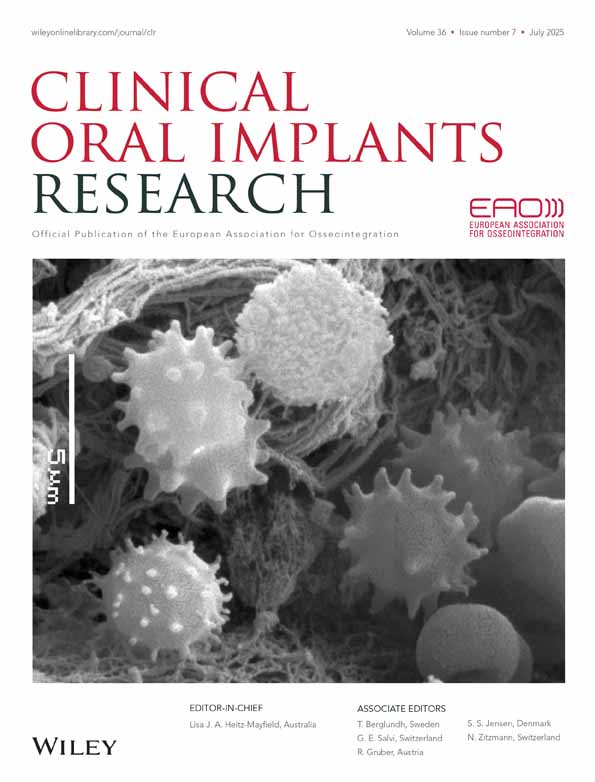Analysis of MG63 osteoblastic-cell response to a new nanoporous implant surface by means of a microarray technology
Die Analyse von MG63 osteoblastenähnlichen Zellen auf einer nanoporöse Implantatoberfläche mittels einer Mikroordnungstechnologie
Abstract
enAbstract: Surface implant modifications have been shown to have a relevant importance in modifying cell response. Expression profiling by DNA microarray is a new molecular technology that allows the analysis of gene expression in a cell system. By using DNA microarrays containing 19,200 genes, we identified in osteoblast-like cells line (MG-63) on new implant surface (nanoPORE, Out-Link, Sweden and Martina, Due Carrare, Padova, Italy), several genes whose expressions were significantly down-regulated. The differentially expressed genes cover a broad range of functional activities: (a) immunity, (b) vesicular transport (c) apoptosis and cell cycle regulation. It was also possible to detect some genes whose function is unknown. The data reported are, to our knowledge, the first genetic portrait of an implant surface. They can be relevant to better understand the molecular mechanism of implant osseointegration and as a model for comparing other materials.
Résumé
frDes modifications de la surface implantaire se sont révélés capables de modifier la réponse cellulaire. L'expression profilée par le “micro-étalage” ADN est une nouvelle technologie moléculaire qui permet l'analyse de l'expression du gène dans un système cellulaire. En utilisant les “micro-étalages” ADN contenant 19 200 gènes une lignée de cellules ressemblant à des ostéoblastes a été identifiée (MG-63) sur une nouvelle surface implantaire (nanoPORE, Out-Link, Suède & Martina, Italie), différents gènes à l'expression significativement sous-régulée. Les gènes exprimés différentiellement couvraient un large spectre d'activité fonctionnelle : a) l'immunité, b) le transport vésiculaire, c) la régulation du cycle cellulaire et de l'apoptose. Il a été possible de détecter quelques gènes à la fonction inconnue. Les données rapportées seraient le premier portrait génétique de la surface de l'implant. Ces données peuvent être importantes pour mieux connaître le mécanisme moléculaire de l'ostéoïntégration de l'implant et comme modèle de comparaison avec d'autres matériaux.
Zusammenfassung
deEs wurde gezeigt, dass Veränderungen der Implantatoberflächen wichtig für die Modifizierung der Zellantwort sind. Die Erstellung von Expressionsprofilen durch DNA-Mikroordnung ist eine neue molekulare Technologie, welche die Analyse der Genexpression eines Zellsystems erlaubt. Durch die Verwendung der DNA-Mikroordnung mit 19200 Genen war es uns möglich, in einer osteoblastenähnlichen Zelllinie (MG-63) auf einer neuen Implantatoberfläche (nano Pore, Out-link, Sweden & Martina, Italien) diverse Gene zu identifizieren, deren Expression signifikant nach unten reguliert war. Die unterschiedlich ausgedrückten Gene decken ein breites Band von funktionellen Aktivitäten ab: (a) Immunität, (b) Gefässtransport, (c) Apoptosis und Zellzyklusregulation. Es war auch möglich, einige Gene zu entdecken, deren Funktion unbekannt war. Die präsentierten Daten sind, soweit wir wissen, das erste genetische Portrait einer Implantatoberfläche. Sie können relevant sein, um die molekularen Mechanismen der Implantatosseointegration besser zu verstehen und sie können als Modell zum Vergleich von anderen Materialien dienen.
Resumen
esLas modificaciones de las superficies de los implantes han mostrado tener una importancia relevante en la modificación de la respuesta celular. El perfilado de la expresión por medio de microfilas de ADN es una nueva tecnología molecular que permite el análisis de la expresión del gen en un sistema celular. Por medio del uso de microfilas de ADN conteniendo 19,200 genes, hemos identificado en una línea de células tipo osteoblastos (MG-63) en una nueva superficie de implante (nanoPORE, Out-link, Sweden & Martina, Italia), varios genes cuya expresión estaba significativamente infrarregulada. Los genes expresados diferencialmente cubren una amplia gama de actividades funcionales: (a) inmunidad, (b) transporte vesicular (c) apoptosis y regulación del ciclo celular. También fue posible detectar algunos genes cuya función es desconocida. Los datos informados son, a nuestro saber, el primer retrato genético de una superficie implantaria. Pueden ser relevantes para comprender el mecanismo molecular de la osteointegración del implante y como modelo para comparar otros materiales.




